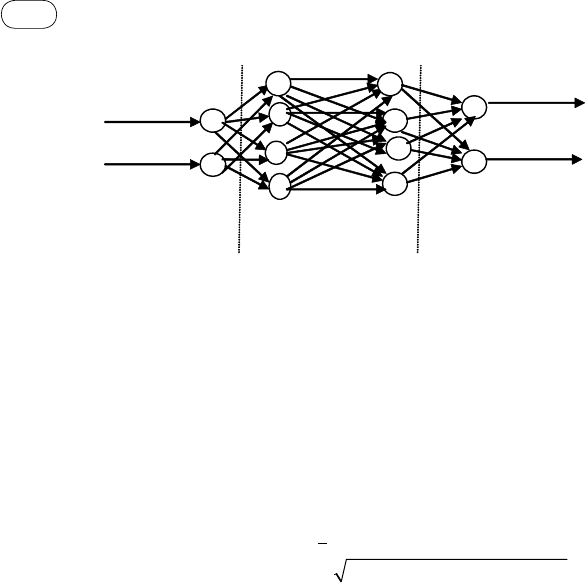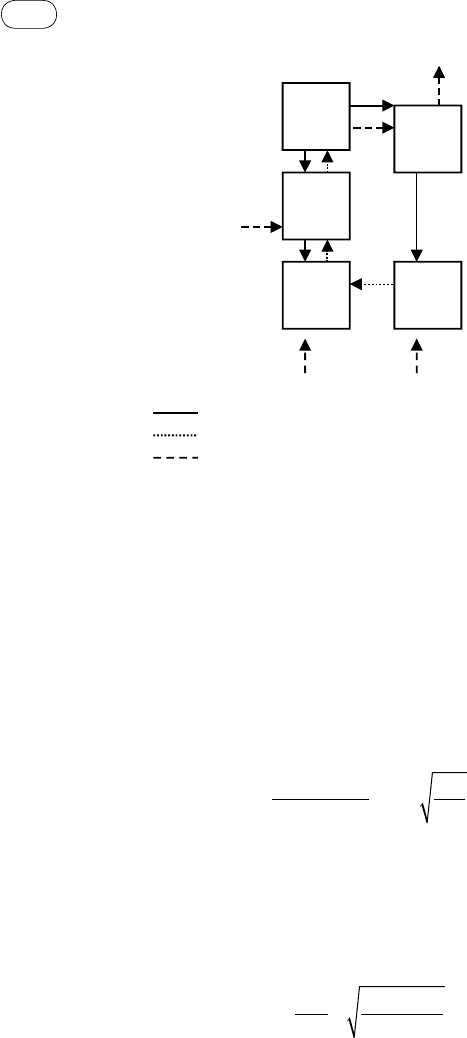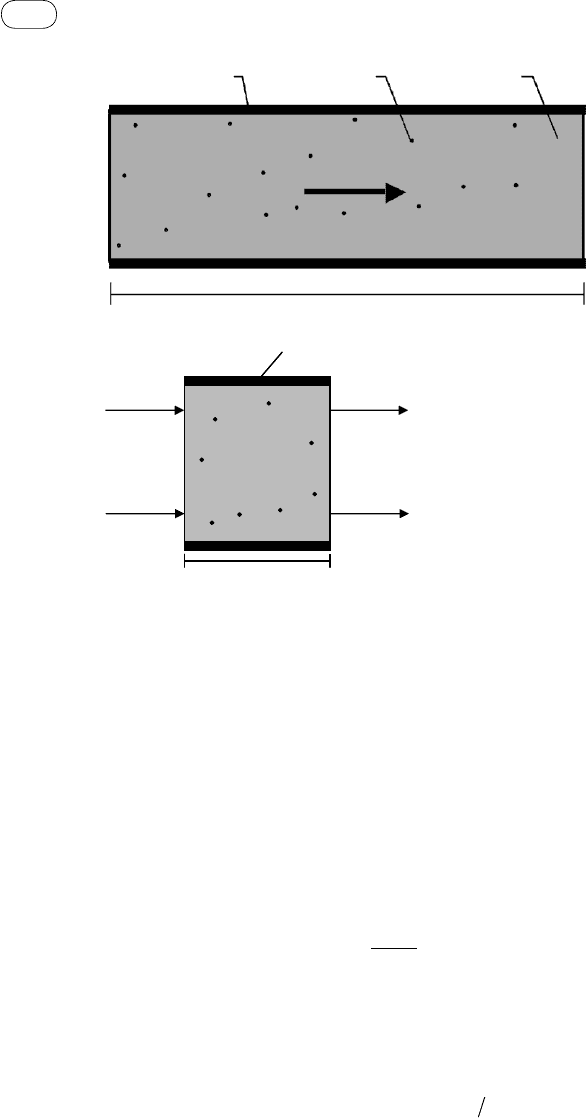Basu P. Biomass Gasification and Pyrolysis: Practical Design and Theory
Подождите немного. Документ загружается.


156
chapter
|
5 Gasification Theory and Modeling of Gasifiers
The ANN model can deal with complex gasification problems. It uses a
high-speed architecture of three hidden layers of neurons (Kalogirou, 2001):
one to receive the input(s), one to process them, and one to deliver output(s).
Figure 5.10 shows the arrangement of neuron layers and the connection patterns
between them. Kalogirou (2001) suggested the following empirical formula to
estimate the number of hidden neurons:
Number of hidden neurons inputs outputs
number of trai
= +
( )
+
1
2
nning patterns
(5.78)
The input layer has two values associated with it: inputs and weights.
Weights are used to transfer data from layer to layer. In the first step, the infor-
mation is processed at the nodes and then added up (summation); the result is
passed through an activation function. The outcome is the node’s “activation
value,” which is multiplied by the specific weight and transferred to the next
node.
Network Training
Training modifies the connection weights in some orderly fashion using learn-
ing methods (Guo et al., 2001). It begins with a set of data (with inputs and
outputs targeted); the weights are adjusted until the difference between the
neural network output and the corresponding target is minimum (Kalogirou
et al., 1999). When the training process satisfies the required tolerance, the
network holds the weights constant and uses the network to make output pre-
dictions. After training, the weights contain meaningful information. A back-
propagation algorithm is used to train the network. Multilayer feed-forward
neural networks are used to approximate the function.
A neural network may return poor results for data that differ from the
original data it was trained with. This happens sometimes when limited data
are available to calibrate and evaluate the constants of the model (Hajek
and Judd, 1995). After structuring the neural network, information starts to
Input layer Hidden layer Output layer
fIGure 5.10 Schematic of a multilayer feed-forward neural network. (Source: Adapted from
Kalogirou, 2001.)

157
5.5 Gasification Models
flow from the input layer to the output layer according to the concepts des-
cribed here.
CFD Models
Computational fluid dynamics can have an important role in the modeling of a
fluidized-bed gasifier. A CFD-based code involves a solution of conservation
of mass, momentum, species, and energy over a defined domain or region. The
equations can be written for an element, where the flux of the just-mentioned
quantities moving in and out of the element is considered with suitable bound-
ary conditions.
A CFD code for gasification typically includes a set of submodels for
the sequence of operations such as the vaporization of a biomass particle, its
pyrolysis (devolatilization), the secondary reaction in pyrolysis, and char
oxidation (Di Blasi, 2008; Babu and Chaurasia, 2004). Further sophistications
such as a subroutine for fragmentation of fuels during gasification and com-
bustion are also developed (Syred et al., 2007). These subroutines can be
coupled with the transport phenomenon, especially in the case of a fluidized-
bed gasifier.
The hydrodynamic or transport phenomenon for a laminar flow situation is
completely defined by the Navier-Stokes equation, but in the case of turbulent
flow a solution becomes difficult. A complete time-dependent solution of the
instantaneous Navier-Stokes equation is beyond today’s computation capabili-
ties (Wang and Yan, 2008), so it is necessary to assume some models for the
turbulence. The Reynolds-averaged Navier-Stokes (k-ε) model or large eddy
simulation filters are two means of accounting for turbulence in the flow.
For a fluidized bed, the flow is often modeled using the Eulerian-Lagrange
concept. The discrete phase is applied to the particle flow; the continuous phase,
to the gas. Overmann and associates (2008) used the Euler-Euler and Euler-
Lagrange approaches to model wood gasification in a bubbling fluidized bed.
Their preliminary results found both to have comparable agreement with exper-
iments. If the flow is sufficiently dilute, the particle–particle interaction and the
particle volume in the gas are neglected.
A two-fluid model is another computational fluid dynamics approach. Finite
difference, finite element, and finite volume are three methods used for discreti-
zation. Commercial software such as ANSYS, ASPEN, Fluent, Phoenics, and
CFD2000 are available for solution (Miao et al., 2008). A review and compari-
son of these codes is given in Xia and Sun (2002) and Norton et al. (2007).
Recent progress in numerical solution and modeling of complex gas–solid
interactions has brought CFD much closer to real-life simulation. If successful,
it will be a powerful tool for optimization and even design of thermochemical
reactors like gasifiers (Wang and Yan, 2008). CFD models are most effective
in modeling entrained-flow gasifiers, where the gas–solid flows are less complex
than those in fluidized beds and the solid concentration is low.

158
chapter
|
5 Gasification Theory and Modeling of Gasifiers
Models developed by several investigators employ sophisticated reaction
kinetics and complex particle–particle interaction. Most of them, however, must
use some submodels, fitting parameters or major assumptions into areas where
precise information is not available. Such weak links in the long array make
the final result susceptible to the accuracy of those “weak links.” If the final
results are known, we can use them to back-calculate the values of the unknown
parameters or to refine the assumptions used.
The CFD model can thus predict the behavior of a given gasifier over a
wider range of parameters using data for one situation, but this prediction might
not be accurate if the code is used for a different gasifier with input parameters
that are substantially different from the one for which experimental data are
available.
5.6 KInetIc Model applIcatIons
This section briefly discusses how kinetic models can be applied to the three
major gasifier types.
5.6.1 Moving-Bed Gasifiers
A basic moving-bed or fixed-bed gasifier can use the following assumptions:
The reactor is uniform radially (i.e., no temperature or concentration gradi-
ent exists in the radial direction).
The solids flow downward (in a updraft gasifier) as a plug flow.
The gas flows upward as a plug flow.
The interchange between two phases takes place by diffusion.
The mass balance of a gas species, j, can be written (Souza-Santos, 2004,
p. 134) as
u
d
dz
D
d
dz
R
g
g j
g j
g j
m j
ρ ρ
,
,
,
,
= +
2
2
(5.79)
where u
g
is the superficial gas velocity, z is the distance, ρ
g,j
is the density of
the jth gas, and D
g,j
is the diffusivity of the jth gas. R
m,,j
, the production or
consumption of the jth gas element, is related to Q
gasification
heat generation or
absorption.
Similarly, an energy balance equation can be written for a dz element as
ρ λ
g pg g g gasification conv rad mass
C u
dT
dz
d T
dz
Q Q Q Q= + + + +
2
2
(5.80)
where, Q
gasification
, Q
conv
, Q
rad
, and Q
mass
are the net heat flow into the element
due to gasification, convection, radiation, and mass transfer, respectively. These
terms can be positive or negative. ρ
g
, C
pg
, and λ
g
are the density, specific heat,
and thermal conductivity of the bulk gas, respectively.

159
5.6 Kinetic Model Applications
Equations (5.79) and (5.80) can be solved simultaneously with appropriate
expression for the reaction rate, R
m,j
.
5.6.2 fluidized-Bed Gasifiers
The kinetic modeling of fluidized-bed gasifiers requires several assumptions or
submodels. It takes into account how the fluidized-bed hydrodynamics is
viewed in terms of heat and mass transfer, and gas flow through the fluidized
bed. The bed hydrodynamics defines the transport of the gasification medium
through the system, which in turn influences the chemical reaction on the
biomass surface. Each of these is subject to some assumptions or involves
submodels.
One can use several versions of the fluidization model:
Two-phase model of bubbling fluidized bed: bubbling and emulsion phases
Three-phase model of bubbling fluidized bed: bubbling, cloud, and emul-
sion phases
Fluidized bed divided into horizontal sections or slices
Core-annulus structure
Gas flow through the bed can be modeled as:
Plug flow in the bubbling phase; ideally mixed gas in the emulsion phase
Ideally mixed gases in both phases
Plug flow in both phases (there is exchange between phases)
Plug flow through the bubble and emulsion phases without mass transfer
between phases
Plug flow of gas upward in the core and solid backflow in the annulus
The following sections present the essentials of a model for a circulating
fluidized-bed combustor and one for a bubbling fluidized-bed gasifier (Kaushal
et al., 2008). A typical one-dimensional steady-state model of a circulating
fluidized-bed combustor, as shown in Figure 5.11, assumes gases as ideal and
in the plug-flow regime. The riser is divided into three hydrodynamic zones:
lower dense bed zone, intermediate middle zone, and top dilute zone. The solids
are assumed uniform in size with no attrition. Char is a homogeneous matrix
of carbon, hydrogen, and oxygen.
A bubbling fluidized-bed gasifier is divided into several zones with different
hydrodynamic characteristics: dense zone and freeboard zone for bubbling
beds; core-annulus for circulating beds. The dense zone additionally deals with
the drying and devolatilization of the introduced feed. Superheated steam is
introduced at the lower boundary of the dense zone. Each zone is further
divided into cells, which individually calculate their local hydrodynamic and
thermodynamic state using chosen equations or correlations. The cells are
solved sequentially from bottom to top, with the output of each considered the
input for the next. The conservation equations for carbon, bed material, and
energy are evaluated not in each cell but across the entire zone. Therefore, each

160
chapter
|
5 Gasification Theory and Modeling of Gasifiers
zone shows a homogeneous char concentration in the bed material and a
uniform temperature. Additional input parameters to the model are geometric
data, particle properties, and flow rates.
Hydrodynamic Submodel (Bubbling Bed)
The dense zone (assumed to be the bubbling bed) is modeled according to the
modified two-phase theory. Bubble size is calculated as a function of bed height
(Darton and LaNauze, 1977), and it is assumed that all bubbles at any cross-
section are of uniform size:
d
U U
g
z
A
N
b
mf
or
=
−
( )
+
0 54 4
0 4
0 2
0 8
.
.
.
.
(5.81)
where A/N
or
is the number of orifices per unit of cross-section area of the bed.
The interphase mass transfer between bubbles and emulsion, essential for
the gas–solid reactions, is modeled semi-empirically using the specific bubble
surface as the exchange area, the concentration gradient, and the mass-transfer
coefficient. The mass-transfer coefficient, K
BE
, based on the bubble–emulsion
surface area (Sit and Grace, 1978), is
K
U D U
d
BE
mf mf r B
B
= +
4
4
ε
π
(5.82)
where U
mf
and ε
mf
are, respectively, fluidization velocity and voidage at a
minimum fluidizing condition, D
r
is the bed diameter, and U
B
is the rise velocity
of a bubble of size d
B
.
Upper zone
Middle zone
Lower zone
Air
Air Air
Loop seal
Gas/air
Solid + gas
Gas
Cyclone
Solid
fIGure 5.11 Model of a circulating fluidized-bed gasifier.

161
5.6 Kinetic Model Applications
The axial mean voidage in the freeboard is calculated using an exponential
decay function.
Reaction Submodel
Gasification reactions proceed at a finite speed; this process is divided into three
steps: drying, devolatilization, and gasification. The time taken for drying and
devolatilization of the fuel is much shorter than the time taken for gasification
of the remaining char. Some models assume instantaneous drying and devola-
tilization because the rate of reaction of the char, which is the slowest, largely
governs the overall process.
The products of devolatilization are CO
2
, CO, H
2
O, H
2
, and CH
4
. The gases
released during drying and devolatilization are not added instantaneously to the
upflowing gas stream, but are added along the height of the gasifier in a
predefined pattern. The total mass devolatilized, m
volatile
, is therefore the sum
of the carbon, hydrogen, and oxygen volatilized from the solid biomass.
m m m m
volatile char hydrogen oxygen
= + + (5.83)
Char gasification, the next critical step, may be assumed to move simultane-
ously through reactions R1, R2, and R3 (Table 5.2). As these three reactions
occur simultaneously on the char particle, reducing its mass, the overall rate is
given as
m m m m
char Boudouard steam methanation
= + + (5.84)
The conversion of the porous char particle may be modeled assuming that
the process follows shrinking particle (diminishing size), shrinking core (dimin-
ishing size of the unreacted core), or progressive conversion (diminishing
density). The shift reaction is the most important homogenous reaction fol-
lowed by steam reforming. The bed materials may catalyze the homogeneous
reactions, but only in the emulsion phase, because the bubble phase is assumed
to be free of solids.
5.6.3 entrained-flow Gasifiers
Extensive work on the modeling of entrained-flow gasifiers is available in the
literature. Computational fluid dynamics (CFD) has been successfully applied
to this gasifier type. This section presents a simplified approach to entrained-
flow gasification following the work of Vamvuka et al. (1995).
The reactor is considered to be a steady-state, one-dimensional plug–flow
reactor in the axial direction and well mixed radially—similar to that shown in
Figure 5.12. Fuel particles shrink as they are gasified. Five gas–solid reactions
(R1–R5 in Table 5.2) can potentially take place on the char particle surface.
The reduction in the mass of char particles is the sum of these individual reac-
tions, so if there are N
c
char particles in the unit gas volume, the total reduction,
W
c
, in the plug flow is as shown in the equation that follows the figure.

162
chapter
|
5 Gasification Theory and Modeling of Gasifiers
dW N A dz r T L
c c k s r
k
= −
( ) ( )
=
∑
,
1
5
(5.85)
where r
k
(T
s
, L
r
) is the surface reaction rate of the kth reaction (one of R1–R5)
at the reactor’s surface temperature, T
s
, and length, L
r
. A is its cross-section
area.
Gaseous reactants diffuse to the char surface to participate in k reactions.
Thus, if a
jk
is the mass of the jth gas, required for the kth reaction, the
overall diffusion rate of this gas from free stream concentration, y
j
, to the char
surface, y
js
, may be related to the total of all reactions consuming the jth gas
as follows:
a r T L r
D P
RT r
y y
jk k s r
k
c
gj
g c
j js
,
( )
= −
( )
=
∑
1
5
2
4
π
(5.86)
where y
js
and y
j
are mole fractions of gas on the char surface and in the bulk
gas, respectively; P is the reactor pressure; and D
gj
is the diffusion coefficient
of the jth gas in the mixture of gases.
The surface reaction rate, r
k
(T
s
,L
r
), may be written in nth-order form as
r T L r K T Py
k s r c sk s js
n
,
( )
=
( )
( )
4
2
π
mol s (5.87)
dL
W
s,L
, T
s,L
F
g,L
, T
g,L
W
s,L+dL
F
g,L+dL
T
L
Reactor wall
Solid phase Gas phase
V
w
T
a
fIGure 5.12 One-dimensional entrained-flow model.

163
5.6 Kinetic Model Applications
where n is the order or reaction, and K
sk
(T
s
) is the surface reaction rate constant
at temperature T
s
.
For conversion of gaseous species, we can write
dF
dZ
N A a r T L
gj
c jk k s r
k
= ±
( )
=
∑
,
1
5
(5.88)
where a
j,k
is the stoichiometric coefficient for the jth gas in the kth reaction.
The total molar flow rate of the jth gas is found by adding the contribution
of each of nine gas–solid and gas–gas reactions:
F F a
gj gj jk k
= +
∑
0
ξ
(5.89)
where F
gj0
is the initial flow rate of the gas.
Energy Balance
Some of the five equations (reactions R1–R5) are endothermic while some are
exothermic. The overall heat balance of reacting char particles is known from
a balance of a particle’s heat generation and heat loss to the gas by conduction
and radiation.
d W C T
dZ
N A r T L H T
r
r
T T
c pc s
c k s r
k
k s
c
g
c
s
( )
= −
( )
( )
+ −
=
∑
,
1
5
2
4
∆
π
λ
gg p c g
T T
( )
+ −
(
)
σ σ
4 4
(5.90)
where C
pc
is the specific heat of the char, ΔH
k
is the heat of reaction of the kth
reaction at the char surface at temperature T
s
, e
p
is the emissivity of the char
particle, λ
g
is the thermal conductivity of the gas, and σ is the Stefan-Boltzmann
constant.
A similar heat balance for the gas in an element dz in length can be carried
out as
d F C T
dZ
A H T
r N A
r
T
gj pg g
j
k k g
k
c C
g
c
g
∑
∑
= −
( )
− −
=
ξ
π
λ
∆
6
9
2
4 TT e T T
h T T e T T D
c p g c
conv g w w g w r
( )
+ −
(
)
− −
( )
+ −
(
)
[ ]
σ
σ π
4 4
4 4
(5.91)
where Δξ
k
is the extent of the gas-phase kth reaction with the heat of reaction,
ΔH
k
(T
g
); h
conv
is the gas-wall convective heat transfer coefficient; and D
r
is the
reactor’s internal diameter.
The first term on the right of Eq. (5.91) is the net heat absorption by the
gas-phase reaction, the second is the heat transfer from the gas to the char
particles, and the third is the heat loss by the gas at temperature T
g
to the wall
at temperature T
w
.

164
chapter
|
5 Gasification Theory and Modeling of Gasifiers
The equations are solved for an elemental volume, A
r
dL
r
, with boundary
conditions from the previous upstream cell. The results are then used to solve
the next downstream cell.
symbols and nomenclature
A = cross-sectional area of bed or reactor (m
2
)
A
0
= pre-exponential coefficient in Eq. (5.42) (s
–1
)
A
b,
A
w
= pre-exponential coefficients in Eqs. (5.44) and (5.47), respectively (bar
–n
s
–1
)
A
j
= total number of atoms of element j entering the reactor (–)
a
i,j =
number of atoms of jth element in ith species (–)
a
jk
= mass of jth gas, required for the kth reaction (kg)
C
i
= molar concentration of ith gas (mol/m
3
)
C
pc
= specific heat of char (kJ/kg.K)
C
pg
= specific heat of the bulk gas
D
r
= internal diameter of the reactor (m)
D
g,j
= diffusion coefficient of the jth gas in the mixture of gases (m
2
/s)
d
b
= diameter of the bubble (m)
E = activation energy (kJ/mol)
e
p
= emissivity of char particle (–)
F
gl0
= initial flow rate of the gas (mol/s)
F
gl =
molar flow rate of the lth gas (mol/s)
G
total
= total Gibbs free energy (kJ)
g = acceleration due to gravity, 9.81 (m/s
2
)
ΔH
k
= heat of reaction of kth reaction at char surface (kJ/mol)
ΔH = enthalpy change (kJ)
h
i
0
,
h
f
0
= heat of formation at reference state (kJ)
h
conv
= gas-wall convective heat transfer coefficient (kW/m
2
K)
h
m
= mass-transfer coefficient (kg carbon/m
2
.bar
2
.s)
k = first-order reaction rate constant (s
–1
)
k
0
= pre-exponential factor (s
–1
)
k
liq
= rate constant for the liquid yield of pyrolysis (s
–1
)
k
BE
= bubble-emulsion mass exchange coefficient (m/s)
k
c
= rate constant for the char yield of pyrolysis (s
–1
)
k
g
= rate constant for the gas yield of pyrolysis (s
–1
)
k
1
= rate constant of three primary pyrolysis reactions taken together (s
–1
)
K = number of element in Eq (5.77)
k
w1
, k
w2
, k
w3
= rate constants in Eq (5.47) (bar
–1
s
–1
)
K
sk =
surface reaction rate constant for kth reaction, mol/m
2
.bar
n
K
e
, K
equilibrium
= equilibrium constant (–)
l = number of gaseous reactants (–)
L
r
= length of the reactor (m)
L = Lagrangian function (–)
m
b
= mass of the biomass in the primary pyrolysis process (kg)
m
0
= initial mass of the biomass (kg)
m
c =
mass of the biomass remaining after complete conversion (kg)
m = reaction order with respect to carbon conversion in Eq. 5.42 (–)

165
5.6 Kinetic Model Applications
m, n, p, q = stoichiometric coefficients in Eqs. 5.27–5.29
n = reaction order with respect to the gas partial pressure, Eq. 5.44 (–)
N = number of species present (–)
N
c
= number of char particles in unit gas volume (–)
N
or
= number of orifices in a bed of area (A
r
)
P
i
= partial pressure of the species i (bar)
P = total pressure of the species (bar)
Q = char gasification rate (kg carbon/m
2
.s)
Q
gasification
, Q
conv
, Q
rad
, and Q
mass
= energy transfer due to gasification, convection, radia-
tion, respectively (kW/m
3
of bed)
R = gas constant (8.314
J/mol.K, or 8.314 × 10
–5
m
3
.bar/mol.K)
R
c
= chemical kinetic reaction rate (kg carbon/m
2
.bar
2
s)
R
m,g,j
= rate of production or consumption of gas species j (kg/m
3
s)
r
i
= reaction rate of the ith reaction (s
–1
)
r
c
= char particle radius (m)
T = temperature (K)
T
s
= surface temperature of char particles (K)
T
g
= gas temperature (K)
T
w =
wall temperature (K)
t = time (s)
u
g
= superficial gas velocity in Eq. 5.80 (m/s)
U = fluidization velocity (m/s)
U
B =
bubble rise velocity (m/s)
U
mf
= minimum fluidization velocity (m/s)
X = fractional change in the carbon mass of the biomass (kg)
y = mole fraction of a species (–)
y
l
= mole fraction of gas in the bulk (–)
y
ls =
mole fraction of gas on the char surface (–)
z = height above grid or distance along a reactor from fuel entry (m)
α
lk
= stoichiometric coefficient for lth gas in kth reaction (–)
β = partition coefficient (–)
λ = Lagrangian multiplier (–)
λ
g
= thermal conductivity of gas (kJ/m.K)
σ = Stefan-Boltzmann constant (5.67 × 10
–8
W m
–2
K
–4
)
ΔG,ΔG
0
= change in Gibbs free energy (kJ)
ΔG
fi
0
= change in Gibbs free energy of formation of species i (kJ)
Δξ
k
= extent of gas-phase kth reaction (–)
ρ
,j
= density of jth gas (kg/m
3
)
ε
mf
= voidage at minimum fluidization condition
ρ
g
= density of the bulk gas
ΔS = entropy change (kJ/K)
